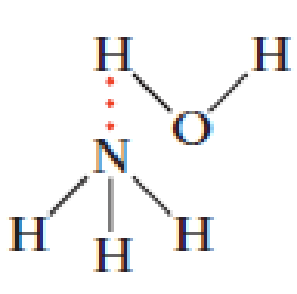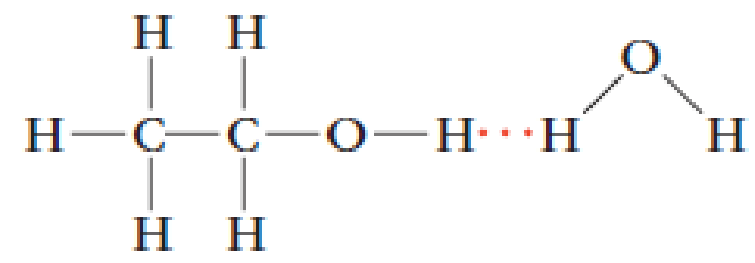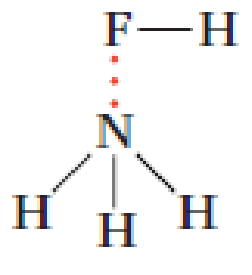
Chemistry: The Molecular Science
5th Edition
ISBN: 9781285199047
Author: John W. Moore, Conrad L. Stanitski
Publisher: Cengage Learning
expand_more
expand_more
format_list_bulleted
Concept explainers
Textbook Question
Chapter 7, Problem 95QRT
Which of these are examples of hydrogen bonding?




Expert Solution & Answer
Trending nowThis is a popular solution!

Students have asked these similar questions
6. The equilibrium constant for the reaction
2 HBr (g)
→ H2(g) + Br2(g)
Can be expressed by the empirical formula
11790 K
In K-6.375 + 0.6415 In(T K-¹)
-
T
Use this formula to determine A,H as a function of temperature. Calculate A,-H at 25 °C and at
100 °C.
3. Nitrosyl chloride, NOCI, decomposes according to
2 NOCI (g) → 2 NO(g)
+ Cl2(g)
Assuming that we start with no moles of NOCl (g) and no NO(g) or Cl2(g), derive an expression
for Kp in terms of the equilibrium value of the extent of reaction, Seq, and the pressure, P.
Given that K₂ = 2.00 × 10-4, calculate Seq/
of
29/no when P = 0.080 bar. What is the new value
по
ƒª/ at equilibrium when P = 0.160 bar? Is this result in accord with Le Châtelier's
Principle?
Consider the following chemical equilibrium:
2SO2(g) + O2(g) = 2SO3(g)
•
Write the equilibrium constant expression for this reaction.
Now compare it to the equilibrium constant expression for the related reaction:
•
.
1
SO2(g) + O2(g) = SO3(g)
2
How do these two equilibrium expressions differ?
What important principle about the dependence of equilibrium constants on the stoichiometry of a
reaction can you learn from this comparison?
Chapter 7 Solutions
Chemistry: The Molecular Science
Ch. 7.2 - Identify the electron-region geometry, the...Ch. 7.2 - Based on the discussion so far, identify a...Ch. 7.2 - Prob. 7.2PSPCh. 7.2 - Determine the electron-region geometry and the...Ch. 7.2 - Prob. 7.2CECh. 7.2 - Prob. 7.3ECh. 7.2 - Prob. 7.4PSPCh. 7.4 - Using hybridization and sigma and pi bonding,...Ch. 7.4 - Prob. 7.4CECh. 7.5 - Decide whether each molecule is polar and, if so,...
Ch. 7.5 - Prob. 7.5ECh. 7.6 - Prob. 7.8PSPCh. 7.6 - Prob. 7.7CECh. 7.6 - Prob. 7.9PSPCh. 7.7 - Prob. 7.8CECh. 7.7 - Prob. 7.9CECh. 7 - Write the Lewis structures and give the...Ch. 7 - The structural formula for the open-chain form of...Ch. 7 - Describe the VSEPR model. How is the model used to...Ch. 7 - What is the difference between the electron-region...Ch. 7 - Prob. 3QRTCh. 7 - Prob. 4QRTCh. 7 - If you have three electron regions around a...Ch. 7 - Prob. 6QRTCh. 7 - Prob. 7QRTCh. 7 - Prob. 8QRTCh. 7 - Prob. 9QRTCh. 7 - Prob. 10QRTCh. 7 - Prob. 11QRTCh. 7 - Prob. 12QRTCh. 7 - Prob. 13QRTCh. 7 - Prob. 14QRTCh. 7 - Prob. 15QRTCh. 7 - Prob. 16QRTCh. 7 - Write Lewis structures for XeOF2 and ClOF3. Use...Ch. 7 - Write Lewis structures for HCP and [IOF4]. Use...Ch. 7 - Prob. 19QRTCh. 7 - Prob. 20QRTCh. 7 - Explain why (I3)+ is bent, but (I3) is linear.Ch. 7 - Prob. 22QRTCh. 7 - Prob. 23QRTCh. 7 - Give approximate values for the indicated bond...Ch. 7 - Give approximate values for the indicated bond...Ch. 7 - Prob. 26QRTCh. 7 - Compare the FClF angles in ClF2+ and ClF2. From...Ch. 7 - Prob. 28QRTCh. 7 - Prob. 29QRTCh. 7 - Prob. 30QRTCh. 7 - Prob. 31QRTCh. 7 - Describe the geometry and hybridization of carbon...Ch. 7 - Describe the geometry and hybridization for each C...Ch. 7 - Describe the hybridization around the central atom...Ch. 7 - The hybridization of the two carbon atoms differs...Ch. 7 - The hybridization of the two nitrogen atoms...Ch. 7 - Identify the type of hybridization, approximate...Ch. 7 - Prob. 38QRTCh. 7 - Prob. 39QRTCh. 7 - Prob. 40QRTCh. 7 - Prob. 41QRTCh. 7 - Methylcyanoacrylate is the active ingredient in...Ch. 7 - Prob. 43QRTCh. 7 - Prob. 44QRTCh. 7 - Prob. 45QRTCh. 7 - Prob. 46QRTCh. 7 - Which of these molecules has a net dipole moment?...Ch. 7 - Prob. 48QRTCh. 7 - Use molecular structures and noncovalent...Ch. 7 - Prob. 50QRTCh. 7 - Explain why water “beads up” on a freshly waxed...Ch. 7 - Explain why water will not remove tar from your...Ch. 7 - Prob. 53QRTCh. 7 - Prob. 54QRTCh. 7 - Prob. 55QRTCh. 7 - Prob. 56QRTCh. 7 - The structural formula for vitamin C is Give a...Ch. 7 - Prob. 58QRTCh. 7 - Prob. 59QRTCh. 7 - Prob. 60QRTCh. 7 - Prob. 61QRTCh. 7 - Prob. 62QRTCh. 7 - Prob. 63QRTCh. 7 - Prob. 64QRTCh. 7 - Prob. 65QRTCh. 7 - Prob. 66QRTCh. 7 - Methylcyanoacrylate is the active ingredient in...Ch. 7 - Prob. 68QRTCh. 7 - Prob. 69QRTCh. 7 - Use Lewis structures and VSEPR theory to predict...Ch. 7 - In addition to CO, CO2, and C3O2, there is another...Ch. 7 - Prob. 72QRTCh. 7 - Prob. 73QRTCh. 7 - Prob. 74QRTCh. 7 - Prob. 75QRTCh. 7 - In the gas phase, positive and negative ions form...Ch. 7 - Prob. 77QRTCh. 7 - Prob. 78QRTCh. 7 - Prob. 79QRTCh. 7 - Prob. 80QRTCh. 7 - Prob. 81QRTCh. 7 - Prob. 82QRTCh. 7 - Prob. 83QRTCh. 7 - Prob. 84QRTCh. 7 - Prob. 85QRTCh. 7 - Prob. 86QRTCh. 7 - Prob. 87QRTCh. 7 - Prob. 88QRTCh. 7 - Prob. 89QRTCh. 7 - Prob. 90QRTCh. 7 - Prob. 91QRTCh. 7 - Prob. 92QRTCh. 7 - Prob. 93QRTCh. 7 - Prob. 94QRTCh. 7 - Which of these are examples of hydrogen bonding?Ch. 7 - Prob. 96QRTCh. 7 - Prob. 97QRTCh. 7 - Prob. 98QRTCh. 7 - Halothane, which had been used as an anesthetic,...Ch. 7 - Ketene, C2H2O, is a reactant for synthesizing...Ch. 7 - Gamma hydroxybutyric acid, GHB, infamous as a date...Ch. 7 - There are two compounds with the molecular formula...Ch. 7 - Piperine, the active ingredient in black pepper,...Ch. 7 - Prob. 105QRTCh. 7 - Two compounds have the molecular formula N3H3. One...Ch. 7 - Prob. 108QRTCh. 7 - Prob. 109QRTCh. 7 - Prob. 110QRTCh. 7 - Prob. 111QRTCh. 7 - Prob. 7.ACPCh. 7 - Prob. 7.BCPCh. 7 - Prob. 7.CCPCh. 7 - Prob. 7.DCP
Knowledge Booster
Learn more about
Need a deep-dive on the concept behind this application? Look no further. Learn more about this topic, chemistry and related others by exploring similar questions and additional content below.Similar questions
- Given Kp for 2 reactions. Find the Kp for the following reaction: BrCl(g)+ 1/2 I2(g) ->IBr(g) + 1/2 Cl2(g)arrow_forwardFor a certain gas-phase reaction at constant pressure, the equilibrium constant Kp is observed to double when the temperature increases from 300 K to 400 K. Calculate the enthalpy change of the reaction, Ah, using this information.arrow_forwardHydrogen bonding in water plays a key role in its physical properties. Assume that the energy required to break a hydrogen bond is approximately 8 kJ/mol. Consider a simplified two-state model where a "formed" hydrogen bond is in the ground state and a "broken" bond is in the excited state. Using this model: • Calculate the fraction of broken hydrogen bonds at T = 300 K, and also at T = 273 K and T = 373 K. • At what temperature would approximately 50% of the hydrogen bonds be broken? • What does your result imply about the accuracy or limitations of the two-state model in describing hydrogen bonding in water? Finally, applying your understanding: • Would you expect it to be easier or harder to vaporize water at higher temperatures? Why? If you were to hang wet laundry outside, would it dry more quickly on a warm summer day or on a cold winter day, assuming humidity is constant?arrow_forward
- (3 pts) Use the Kapustinskii equation to calculate the lattice enthalpy for MgBr2 anddiscuss any differences between this result and that from #4.arrow_forward(3 pts) Silver metal adopts a fcc unit cell structure and has an atomic radius of 144 pm. Fromthis information, calculate the density of silver. Show all work.arrow_forward4. (3 pts) From the information below, determine the lattice enthalpy for MgBr2. Show all work. AH/(kJ mol-¹) Sublimation of Mg(s) +148 lonization of Mg(g) +2187 to Mg2+(g) Vaporization of Br₂(1) +31 Dissociation of Br,(g) +193 Electron gain by Br(g) -331 Formation of MgBr₂(s) -524arrow_forward
- 1. (4 pts-2 pts each part) Consider the crystal structures of NaCl, ZnS, and CsCl (not necessarily shown in this order). a. For one of the three compounds, justify that the unit cell is consistent with stoichiometry of the compound. b. In each of the crystal structures, the cations reside in certain holes in the anions' packing structures. For each compound, what type of holes are occupied by the cations and explain why those particular types of holes are preferred.arrow_forward(2 pts) What do you expect to happen in a Na2O crystal if a Cl− ion replaces one of the O2−ions in the lattice?arrow_forward(2 pts) WSe2 is an ionic compound semiconductor that can be made to be p-type or n-type.What must happen to the chemical composition for it to be p-type? What must happen tothe chemical composition for it to be n-type?arrow_forward
- 8. (2 pts) Silicon semiconductors have a bandgap of 1.11 eV. What is the longest photon wavelength that can promote an electron from the valence band to the conduction band in a silicon-based photovoltaic solar cell? Show all work. E = hv = hc/λ h = 6.626 x 10-34 Js c = 3.00 x 108 m/s 1 eV 1.602 x 10-19 Jarrow_forwardA solution containing 100.0 mL of 0.155 M EDTA buffered to pH 10.00 was titrated with 100.0 mL of 0.0152 M Hg(ClO4)2 in a cell: calomel electrode (saturated)//titration solution/Hg(l) Given the formation constant of Hg(EDTA)2-, logKf= 21.5, and alphaY4-=0.30, find out the cell voltage E. Hg2+(aq) + 2e- = Hg(l) E0= 0.852 V E' (calomel electrode, saturated KCl) = 0.241 Varrow_forwardFrom the following reduction potentials I2 (s) + 2e- = 2I- (aq) E0= 0.535 V I2 (aq) + 2e- = 2I- (aq) E0= 0.620 V I3- (aq) + 2e- = 3I- (aq) E0= 0.535 V a) Calculate the equilibrium constant for I2 (aq) + I- (aq) = I3- (aq). b) Calculate the equilibrium constant for I2 (s) + I- (aq) = I3- (aq). c) Calculate the solubility of I2 (s) in water.arrow_forward
arrow_back_ios
SEE MORE QUESTIONS
arrow_forward_ios
Recommended textbooks for you
 Chemistry: The Molecular ScienceChemistryISBN:9781285199047Author:John W. Moore, Conrad L. StanitskiPublisher:Cengage LearningChemistry: Matter and ChangeChemistryISBN:9780078746376Author:Dinah Zike, Laurel Dingrando, Nicholas Hainen, Cheryl WistromPublisher:Glencoe/McGraw-Hill School Pub Co
Chemistry: The Molecular ScienceChemistryISBN:9781285199047Author:John W. Moore, Conrad L. StanitskiPublisher:Cengage LearningChemistry: Matter and ChangeChemistryISBN:9780078746376Author:Dinah Zike, Laurel Dingrando, Nicholas Hainen, Cheryl WistromPublisher:Glencoe/McGraw-Hill School Pub Co
 Introductory Chemistry: An Active Learning Approa...ChemistryISBN:9781305079250Author:Mark S. Cracolice, Ed PetersPublisher:Cengage Learning
Introductory Chemistry: An Active Learning Approa...ChemistryISBN:9781305079250Author:Mark S. Cracolice, Ed PetersPublisher:Cengage Learning Chemistry for Engineering StudentsChemistryISBN:9781337398909Author:Lawrence S. Brown, Tom HolmePublisher:Cengage Learning
Chemistry for Engineering StudentsChemistryISBN:9781337398909Author:Lawrence S. Brown, Tom HolmePublisher:Cengage Learning Chemistry by OpenStax (2015-05-04)ChemistryISBN:9781938168390Author:Klaus Theopold, Richard H Langley, Paul Flowers, William R. Robinson, Mark BlaserPublisher:OpenStax
Chemistry by OpenStax (2015-05-04)ChemistryISBN:9781938168390Author:Klaus Theopold, Richard H Langley, Paul Flowers, William R. Robinson, Mark BlaserPublisher:OpenStax

Chemistry: The Molecular Science
Chemistry
ISBN:9781285199047
Author:John W. Moore, Conrad L. Stanitski
Publisher:Cengage Learning

Chemistry: Matter and Change
Chemistry
ISBN:9780078746376
Author:Dinah Zike, Laurel Dingrando, Nicholas Hainen, Cheryl Wistrom
Publisher:Glencoe/McGraw-Hill School Pub Co


Introductory Chemistry: An Active Learning Approa...
Chemistry
ISBN:9781305079250
Author:Mark S. Cracolice, Ed Peters
Publisher:Cengage Learning

Chemistry for Engineering Students
Chemistry
ISBN:9781337398909
Author:Lawrence S. Brown, Tom Holme
Publisher:Cengage Learning

Chemistry by OpenStax (2015-05-04)
Chemistry
ISBN:9781938168390
Author:Klaus Theopold, Richard H Langley, Paul Flowers, William R. Robinson, Mark Blaser
Publisher:OpenStax
Stoichiometry - Chemistry for Massive Creatures: Crash Course Chemistry #6; Author: Crash Course;https://www.youtube.com/watch?v=UL1jmJaUkaQ;License: Standard YouTube License, CC-BY
Bonding (Ionic, Covalent & Metallic) - GCSE Chemistry; Author: Science Shorts;https://www.youtube.com/watch?v=p9MA6Od-zBA;License: Standard YouTube License, CC-BY
General Chemistry 1A. Lecture 12. Two Theories of Bonding.; Author: UCI Open;https://www.youtube.com/watch?v=dLTlL9Z1bh0;License: CC-BY